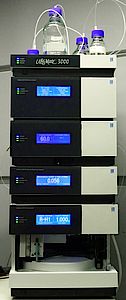Equipment
With the beginning of 2013, the mass spectrometers and nano-HPLCs of the IMP/IMBA/GMI protein chemistry facility and the MFPL present at the campus were integrated into the Vienna Biocenter Core Facilities (VBCF). Since then, the VBCF provides a pool of mass spectrometers and nano-HPLCs. This equipment pool is overseen, managed and maintained by the Proteomics facility.
The following instruments are available for the facility:
- 5 Orbitrap Exploris 480 (Thermo Scientific)
- 1 Orbitrap Eclipse (Thermo Scientific)
- 1 TimsTOF Pro (Bruker)
- 1 Q-TOF Synapt G2 (Waters)
- 1 MALDI-TOF/TOF 4800 (Sciex, used for characterization of synthetic peptides)
- HPLCs
Orbitrap Exploris 480 (Thermo Scientific)
The facility operates 5 OrbiTrap Exploris 480 mass spectrometer (ThermoFisher), which are used to analyze the major part of the submitted samples. This mass spectrometer uses a high-capacity transfer tube for maximum ion loading, an electrodynamic ion funnel that accommodates and transmits ions over a broader mass range, and a high-field Orbitrap mass analyzer with a resolution of 480000 (FWHM) at m/z 200. The Advanced Peak Determination (APD) algorithm significantly increases the number of precursors available for data-dependent analysis, which in turn results in more MS/MS spectra, and peptide identifications.
Most importantly, the FAIMS-PRO device adds a new dimension of selectivity. The application of FAIMS leads to a reduction of chemical noise, leading to better signal to noise ratios. The instrument has to be cleaned at intervals of about 6 months. The FAIMS-PRO device has to be cleaned every 3 weeks.
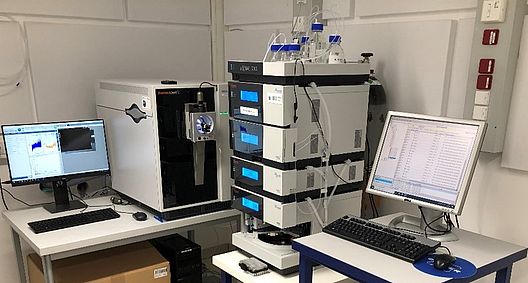
Orbitrap Eclipse (Thermo Scientific)
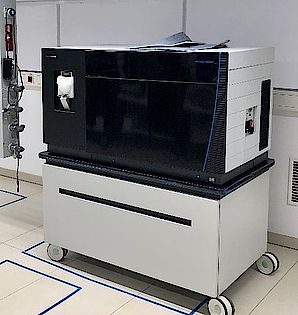
The Orbitrap Eclipse Tribrid mass spectrometer (ThermoFisher) includes 3 mass analyzers, i.e. a quadrupole mass filter, a linear ion trap and an Orbitrap mass analyzer and 2 detectors. The instrument allows different and partially complementary fragmentation techniques, which are collision induced dissociation (CID), higher-energy collisional dissociation (HCD), electron transfer dissociation (ETD) and a combination of ETD and HCD called EThcD.
One application of this instrument is multiplex quantitation of TMT-labelled samples as this instrument offers a novel method called MultiNotch MS3 combined with real time search option, which provides a higher accuracy of TMT quantification. Additionally, we use the instrument for the analysis of peptides with labile post-translational modifications such as arginine phosphorylation.
TimsTOF Pro (Bruker)
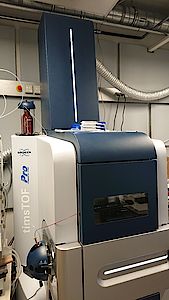
The timsTOF Pro (Bruker) is a time-of -flight instrument coupled to a dual Trapped Ion Mobility Spectrometry (TIMS) analyser. Here, ions are separated in the gas phase based on their ion mobility which adds a 3rd dimension of separation in addition to retention time and m/z. The design of the dual TIMS device allows for ions to be accumulated in the first part of the analyser, while they are sequentially released dependent on their ion mobility from the second section (PASEF; Parallel Accumulation and Serial Fragmentation). Thereby a duty cycle of nearly 100% is achieved resulting in nearly no ion loss. The design of the instrument offers a high sequencing speed (up to 100Hz) by synchronizing the quadrupole isolation mass window with the elution time of the specific peptide packages from the TIMS funnel. This design allows to reach new depths in shotgun proteomics and phosphoproteomics, using low sample amounts.
MS instruments used for shotgun proteomics require cleaning when run 24 hours a day on large sample numbers, and performance degradation can be noticeable over short time periods. The superior robustness of the timsTOF Pro allows the instrument to be run 24/7 over many days or weeks without noticeable loss of sensitivity or other performance metrics.
Q-TOF Synapt G2 (Waters)

We use this mass spectrometer for the characterization of intact proteins. The Q-TOF Synapt G2 employs a quadrupole for the selection of precursor ions, a second quadrupole for fragmention and a time-of-flight tube for the mass analysis. The instrument is coupled to a chromatography system using a microscale C4 column, which allows chromatographic separation of proteins before being ionized in a microspray source and entering the MS. The instrument is equipped with a high-efficiency T-Wave ion mobility technology, which gives access to an additional dimension of separation, based on molecular size and shape. As Ion mobility experiments are time consuming and difficult they are not offered as a service but can be done project based. The acquisition and the operation of this instrument is based on a joint initiative with the MFPL mass spectrometry facility.
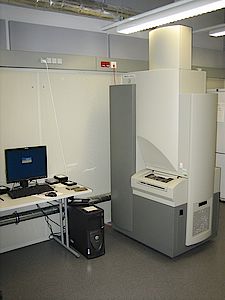
ABI 4800 MALDI TOF/TOF (AB Sciex)
The ABSCIEX 4800 MALDI TOF/TOF is used for controlling the quality of synthetic peptides generated in house, for the mass measurement of intact proteins and for glycan analysis.
Nano reversed phase HPLC
All state of the art mass spectrometers described above (except the MALDI-TOF/TOF) are coupled on-line to nano-LCs (Dionex UltiMate 3000 Rapid Separation LCs; Thermo Scientific). For peptide separation prior to MS reversed phase C18 columns are used with a pre-column set-up to allow for online desalting and pre-concentration. For separation of intact proteins prior to MS reversed phase C4 columns or size exclusion columns are used.
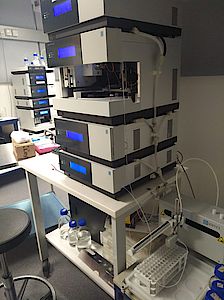
HPLC for off-line sample fractionation
In cases were two-dimensional separations are required we employ off-line chromatography, mainly but not exclusively, strong cation exchange chromatography. This instrument is connected to a fraction collector.
